

10.12804/revistas.urosario.edu.co/economia/a.14427
Jorge Leonardo Rodríguez Arenas 1
Luis Fernando Gamboa 2
*We thank the Office of Research Project Management-Icfes for their useful comments and access to the data. We also thank Lorena Trujillo, Daniel Cañizares, Valentina Daza, and Felipe Lizarazo for their comments and suggestions. This research was conducted within the framework of the Icfes internal research project called "Asymmetry ICT". All errors are the sole responsibility of the authors and do not reflect on their institutions.
1 Oficina de Gestión de Proyectos de Investigaciones-ICFES.
![]() jlrodrigueza@icfes.gov.co.
jlrodrigueza@icfes.gov.co.
![]() 0000-0001-6010-511X
0000-0001-6010-511X
2 Adjunct Professor, Department of Economics Pontificia Universidad Javeriana.
![]() lfgamboa@gmail.com.
lfgamboa@gmail.com.
![]() 0000-0002-7273-7381
0000-0002-7273-7381
Recibido: 3 de agosto de 2024
Aceptado: 22 de octubre de 2024
Para citar este artículo: Rodríguez Arenas, J. L., & Gamboa, L. F. (2023). Debunking Myths: Do ICT Really Favor One Gender in Middle Education? The Case of Colombia. Revista de Economía del Rosario, 26(2), 1-31. https://doi.org/10.12804/revistas.urosario. edu.co/economia/a.14427
Abstract
This paper analyzes the impact of Information and Communication Technologies (ICT) on the academic performance of students in Colombia, specifically in mathematics and reading. Using data from secondary school students between 2017 and 2019, ICT access is measured through the availability of computers and Internet. The results indicate that access to ICT improves mathematics scores by 0.068 standard deviations, while no significant effect is observed in reading. Additionally, having a computer without Internet access does not affect scores. These findings provide relevant insights for policies aimed at reducing the digital divide. No differential effects are found between males and females.
Keywords: information and communication technologies; standardized tests; gender gaps. JEL:C13, C21, I24, H44
Resumen
Este artículo analiza el impacto de las Tecnologías de la Información y Comunicación (TIC) en el rendimiento académico de estudiantes en Colombia, específicamente en matemáticas y lectura. Utilizando datos de estudiantes de secundaria entre 2017 y 2019, se mide el acceso a tic a través de la disponibilidad de computadoras e Internet. Los resultados indican que el acceso a tic mejora las puntuaciones en matemáticas en 0.068 desviaciones estándar, mientras que no se observa un efecto significativo en lectura. Además, tener una computadora sin acceso a Internet no impacta las puntuaciones. Estos hallazgos proporcionan información relevante para políticas que buscan reducir la brecha digital. No se encuentran efectos diferenciales entre hombres y mujeres.
Palabras clave: tecnologías de la información y la comunicación; pruebas estandarizadas; brechas de género.
Resumo
Neste artigo, analisa-se o impacto das tecnologias da informação e da comunicação (TICS) no desempenho académico dos alunos na Colômbia, especificamente em matemática e leitura. A partir de dados de alunos do ensino fundamental II entre 2017 e 2019, o acesso às TICS é medido por meio da disponibilidade de computadores e da internet. Os resultados indicam que o acesso às tics melhora as pontuações em matemática em 0,068 desvios-padrão, enquanto nenhum efeito significativo é observado em leitura. Além disso, ter um computador sem acesso à internet não tem impacto nas pontuações. Essas descobertas fornecem informações relevantes para políticas destinadas a reduzir a exclusão digital. Não foram encontrados efeitos diferenciados entre homens e mulheres.
Palabras clave: tecnologias de informação e comunicação; testes padronizados; diferenças de género.
1. Introduction
The global rapid technological growth has highlighted the challenge of strengthening the skills associated with the use of Information and Communication Technologies (ICT) in the educational system (Goolsbee & Guryan, 2006; Leuven et al., 2007). However, as Hanafizadeh et al. (2009) and Angrist and Lavy (2002) suggest, it isn't easy to obtain an accurate measure of ICT (computers, tablets, smartphones, software or educational programs, and the Internet) that provide unique evidence about how ICT affect the educational process (Barrera-Osorio & Linden, 2009; Bulman & Fairlie, 2016; Checchi, et al., 2019; Lei & Zhao, 2007).
Some studies have estimated the causal effect of ICT on students' performance and found either little or no effect (Barrera-Osorio and Linden, 2009; Checchi et al., 2019; Cristia et al., 2017; Román & Murillo, 2012). The effects of ICT-based social media factors on adolescents' digital reading differ according to whether the access was at school or at home (Gil-Flores et al., 2012; Hu & Yu, 2021; Kirschner & Karpinski, 2010; Lambić, 2016; Muls, et al., 2020; Wu & Peng, 2017). At an aggregate level, Skryabin et al., (2015) found a positive association between the national ICT development level and academic performance in reading, mathematics, and sciences.
Having evidence on how ICT affect issues such as gender gaps in learning enables policy-makers and educators to develop more equitable and inclusive strategies, ensuring access to the opportunities offered by the digital world. ICT have the potential to improve access to education, but without inclusive leadership, it may perpetuate gender gaps in education and technological skill development (such as programming, data analysis, or the use of digital platforms), reinforcing inequalities in areas like the labor market (Campos & Scherer, 2024). Proficiency in ICT is essential in an increasingly digital world. However, if both sexes are not provided with equal opportunities to learn and contribute to the technology field, diversity in the development of technological solutions is diminished.
Digital gender divide refers to the disparities in Internet use between men and women in aspects such as access, digital skills, and engagement with online platforms. The access and the type of use determine alternative benefits or drawbacks for learning in students (Basavaraja & Sampath Kumar, 2017; Feng et al., 2019; Junco, 2012). Additional time spent on the Internet reduces the hours available for learning-related activities (reading, solving exercises and practicing, among others), but using Internet can strengthen some skills that may even include learning programming or develop software applications (Hunley et al., 2005; Lei & Zhao, 2007; Posso, 2016).
In developing countries, women are less likely to own devices (smart-phones, tablets or computers) with access to the Internet compared to men, probably because of economic, social, and cultural barriers. For example, in some cultures, women experience more financial constraints, and the use of technology is prioritized in men. In addition, women are disproportionately affected by online harassment which can deter their participation on the Internet. Therefore, the global Internet user gender gap for 2020 was 17 % (International Telecommunication Union, ITU, 2020). Addressing this gap is critical as digital access plays a significant role in opportunities for new education programs, employment, and social participation.
There are also differences in how they use the Internet. Some studies show that men are more likely to use the Internet for activities like gaming, coding, or accessing information related to technology and finance, while women tend to use the Internet more for social net-working, communication, education, e-commerce, family management or health information (Martínez-Domínguez & Mora-Rivera, 2020; Su et al., 2020; Weiser, 2000).
The objective of this paper is to provide evidence on the effects generated by access to ICT on academic performance in the standardized national test and to determine whether this access helps explain the gender score gaps obtained in these tests between men and women.
Access to ICT will be measured through the availability of computers and the Internet at home. Although a complementarity between computers and the Internet exists, most of the recent technological advances allow people to obtain access to the Internet through other different devices (smartphones or tablets among others). For example, 23.39% of the Colombian ninth-grade students reported Internet access without home computer in 2017.
We utilize an unbalanced panel of middle school students built by ICFES (a public institution responsible for measuring the quality of education in Colombia) between 2017 and 2019. This panel allows us to observe the same students in two periods: when they were in 9th grade in 2017 and again when they reached 11th grade in 2019. By tracking the same students over time, we can reduce bias in the estimated gaps caused by unobserved factors. In 2017, ICFES administered the Saber 9 test, assessing mathematics and reading comprehension, to all ninth-grade students (520,013 students) in more than 10,000 schools.
The empirical strategy adopted in this paper consists on estimating a traditional difference-in-differences (DiD) model that explains the test score achieved in mathematics and reading scores in the Saber 11 test after controlling for the Saber 9 score which allows us to control for initial differences in cognitive competencies.1 The treatment variable is the access to ICT, so two different variables are constructed to take into account different intensities. The first variable is whether the student has access to a computer at home, and the second variable adds the access to the Internet to the first indicator. This strategy assumes that access is equally distributed within classrooms and access to ICT can be underestimated in the sample because of the connectivity through other devices.
Our results indicate that access to ICT actually generates a positive effect on mathematics and most of this result is explained by access to the Internet. For reading, the effect is small and is also driven by the access to the Internet. An additional result is that there is no evidence of gender digital divide in middle education.
The document contributes to the literature regarding performance differences in standardized tests for developing countries by using a student panel available for the first time in Colombia. Recent evidence suggests that some of the reasons behind these gender differential results is opportunity cost (Muñoz, 2018). Also, Ome & Gamboa (2021) state that permanence in the school system is biased between boys and girls for the case of Colombia.
Secondly, it adds to the recent evidence on the Digital Divide, in terms of access to information and communication technologies by students at the end of their school education. Specifically, it explores whether this access can explain differential outcomes in standardized tests, given the Internet's opportunities for academic knowledge. Differences in access to ICT may have implications for academic performance and future employability, either in terms of the type of career they choose or their competitiveness in the labor market. Lastly, this document also provides an updated measurement of access to ICT by the ICFES.
The document is divided as follows. Section 2 presents a brief description of the information available in the Saber 9 and 11 test databases and the main characteristics of the student population considered. Section 3 includes the empirical strategy, Section 4 the main results, and Section 5 presents the robustness of the results. Finally, in Section 6 the main findings are discussed.
2. Data
This document uses the administrative records from the Colombian Institute for the Evaluation of Education (ICFES, for its acronym in Spanish). For this analysis, the results of two academic tests (Saber 9 Test from 2017 and the Saber 11 Test from 2019) were merged using a unique individual identifier provided by ICFES. This allows, for the first time, tracking students between these two assessments, as the Saber 9 test was administered to all 9th-grade students.
The Saber 9 test evaluates competencies in reading—such as textual writing, comprehension and interpretation, literature, media, and other symbolic systems—and mathematics, including numbers and numeration (meaning and structure of the numerical system; operations and their properties), geometric analysis (representations of objects in space and their transformations), and random analysis (data analysis and inferences).
The Saber 11 test is the mandatory high school exit exam in Colombia and serves as an indicator of the competencies achieved by students at the end of secondary education. It is used for purposes such as admission to higher education and the granting of scholarships.2 Since 2014, the exam has been divided into five areas of knowledge: critical reading, mathematics, natural sciences, social sciences, and English. Students receive separate scores for each area and an aggregate score ranging from 0 to 500. Each area score ranges from 0 to 100, with the test adjusted so that each area has a mean of approximately 50 points and a standard deviation of about 10.
Out of the initial 520.013 students who took the Saber 9 test, only 357.060 attended the Saber 11 test in 2019. The 31.3 % of students who did not attend may be repeaters or dropouts, and this attrition will be considered in the analysis of the estimated model.
Table 1 shows that females represent 52 % of the population and are younger in average age than males in the Saber 9 test from 2017. About 3 of each 4 students attend to a school managed by the public sector and 94 % out of the total students come from mixed-gender-schools. There is a higher proportion of females than males in official schools, while in rural and mixed schools, males predominate. In terms of household characteristics, the proportion of students who have a mother with some type of higher education is approximately 30%, and less than 30 °% of both male and female students lack Internet and computer access. In Saber 11, the situation is very similar, 53 % are women, and more than two-thirds of the population are in public schools, with a predominance of women. The proportion of students with a mother with some type of higher education decreases as compared to Saber 9, and the number of students with no home access to a computer or Internet increases in this exam.
Table 1. Difference of means of control variables by gender
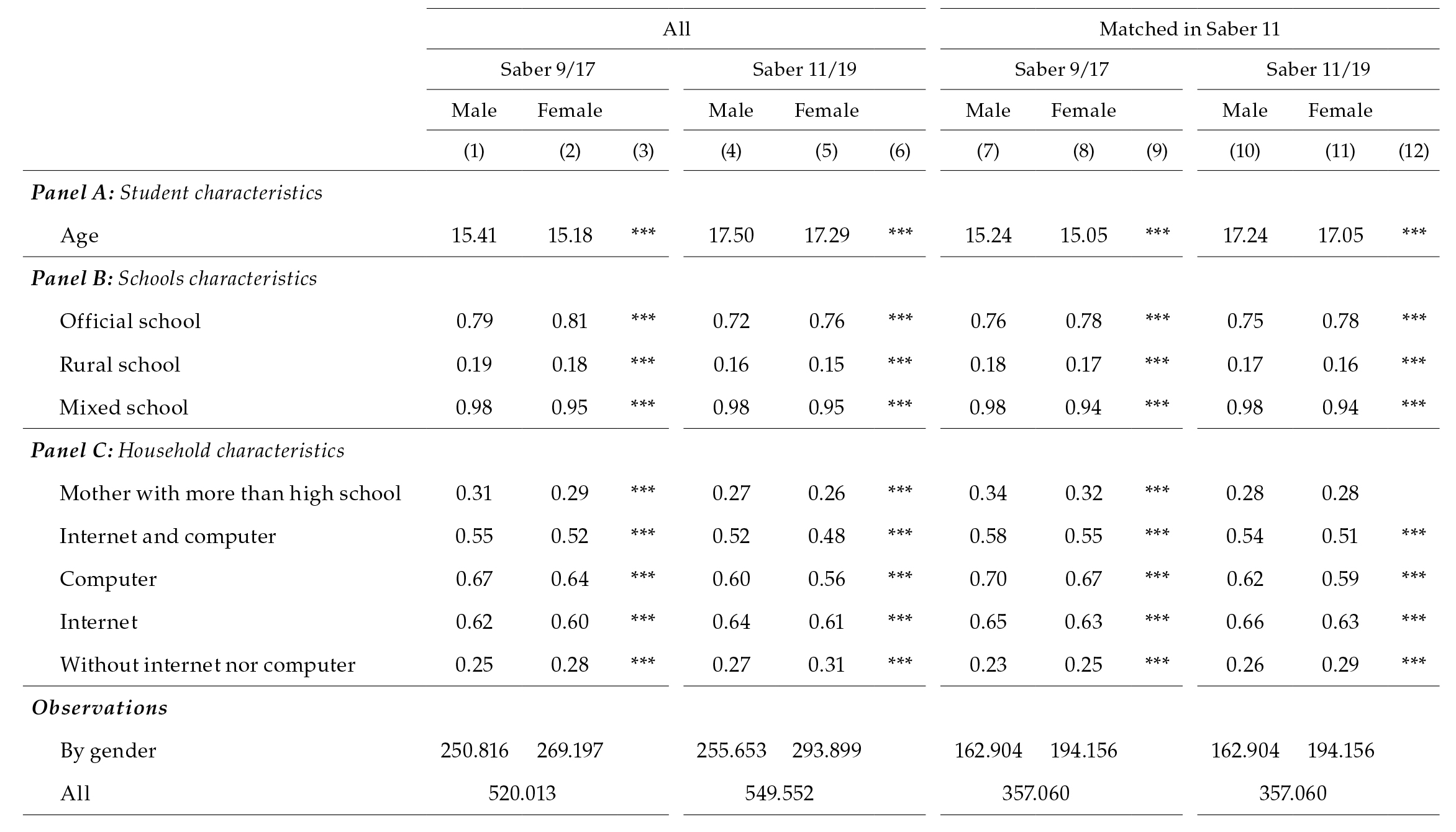
Source: Author's calculations, based on ICFES information. *** p<0.01/ ** p<0.05/ * p<0.1
In this paper we will analyze the scores attained in mathematics and reading because of their importance and their availability in both Saber 9 and Saber 11.3 Given that the scale of test scores is different, we opt for using standardized scores in the estimation and interpretation of the results. Therefore, the results of each test are standardized separately, using the standard deviation and the mean of each time and of each variable.
Table 2 summarizes the average scores by gender controlling for different variables (panel a). In both tests (Saber 9 and 11), the scores obtained in mathematics are lower than those in reading. In addition, while there seems to be a gender advantage in Saber 9 (higher scores achieved by boys in mathematics and the opposite in language), this pattern does not seem to hold in reading at the end of the educational cycle (Saber 11).
Table 2. Average Scores in Saber test
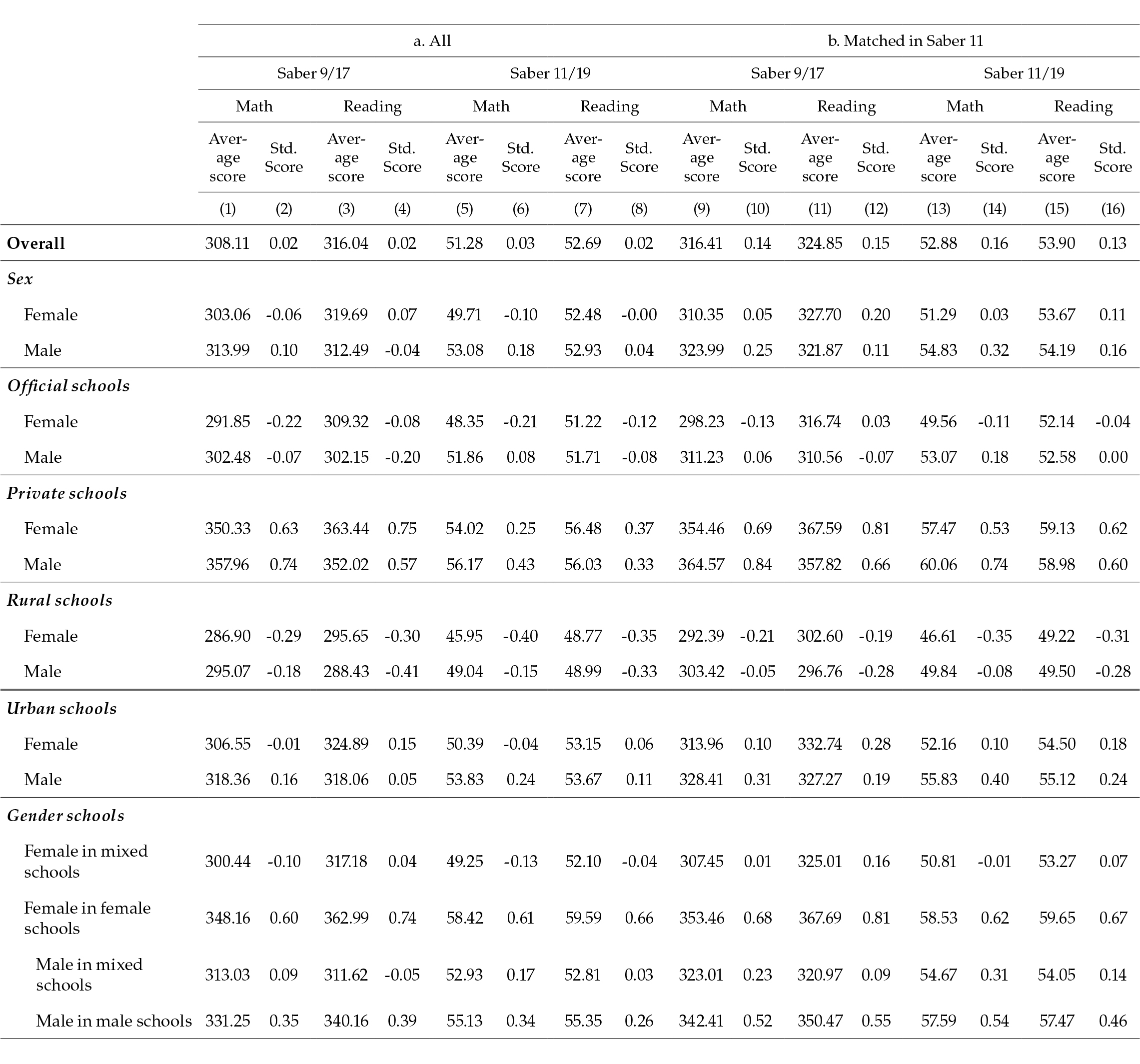
Source: Author's calculations, based on ICFES information.
Moreover, this pattern is similar when the averages are obtained for different samples of schools. That is, in Saber 9, male students outperformed their female counterparts in math, regardless of their school location (rural or urban) or sector (public or private), while female students obtained higher reading scores. In mathematics, females obtained a standardized score of -0.06 and -0.1 in Saber 9 and Saber 11, respectively. That is, below the national average. In reading, the same pattern is not observed since women in Saber 9 are above the national average but not in Saber 11. It is worth noting that both females and males obtained higher average scores in these areas when they attended single-gender schools than in mixed-schools.
Considering the degree of population concentration and economic activity in Colombia, a comparison at the municipal level is presented. In relative terms, 882 municipalities had a higher average performance of females in reading in the Saber 9 test, representing 93.56 % of the total number of Saber 9 students in 2017 (486.524). While in the Saber 11 of 2019 the number of municipalities decreases to 521 or 32.40% (178.054 students). On the other hand, the number of municipalities with higher female performance in mathematics in Saber 9/2017 was 240 (50.026 students, 9.62 °% of the students). In the Saber 11 test, only 107 municipalities (7.818 students) had higher female performance in mathematics.4
3. Empirical Strategy
The identification strategy takes advantage of the access to various ICT at the time of taking the Saber 11 test and the available information related to this access 2 years earlier. The sample to be used in the empirical exercise includes those who took both tests and who have reported information on ICT access in both tests.5 For the purposes of the exercise, the sample is also limited to those who have not had access to ICT in grade 9 (79.302 students). In this way, it is possible to approximate the effect of changes in the condition of ICT access between ninth and eleventh grades on educational achievement in mathematics and reading.
The statistical sample used in the econometric estimation is constructed by limiting students who do not have access to any ICT in grade 9 and those who are observed at the next point in time (grade 11). Therefore, we consider as treated those students who have access in grade 11 and as controls those who report having no access either in grade 9 or in grade 11. In the basic model, three different variables related to access to ICT are introduced in order to consider different levels of intensity of access (intensity of treatment). First, the variable D is equal to 1 if the student in Saber 11 already had access to computer and Internet and zero if not (6.587 students). Second, D is equal to 1 if the student in Saber 11 only had access to computer (5.789 students) and zero otherwise. Finally, D equals 1 if the student in Saber 11 only had access to Internet (8.643 students) and zero otherwise. On the other hand, the control group includes those who did not report ICT access (58.283 students).
Table 3 shows the balance between control and treated individuals for different covariates in the pre- and post-treatment period. Statistically significant differences can be observed between students belonging to the control and treatment groups for the pre-treatment year in variables such as age, the proportion of students from official, rural and mixed schools, and in the percentage of students who have more human capital at home (mother with some type of higher education). These differences are also found in the post-treatment period. However, differences in variables such as age, the proportion of students in rural and mixed schools remain constant over time. To account for these differences between groups and over time in our estimates, we control tor sample balancing covariates in the econometric model that are estimated because accounting for them improves the precision of the estimator as they reduce the residual variance and also make the assumption of parallel trends more plausible.
Table 3. Covariate balancing
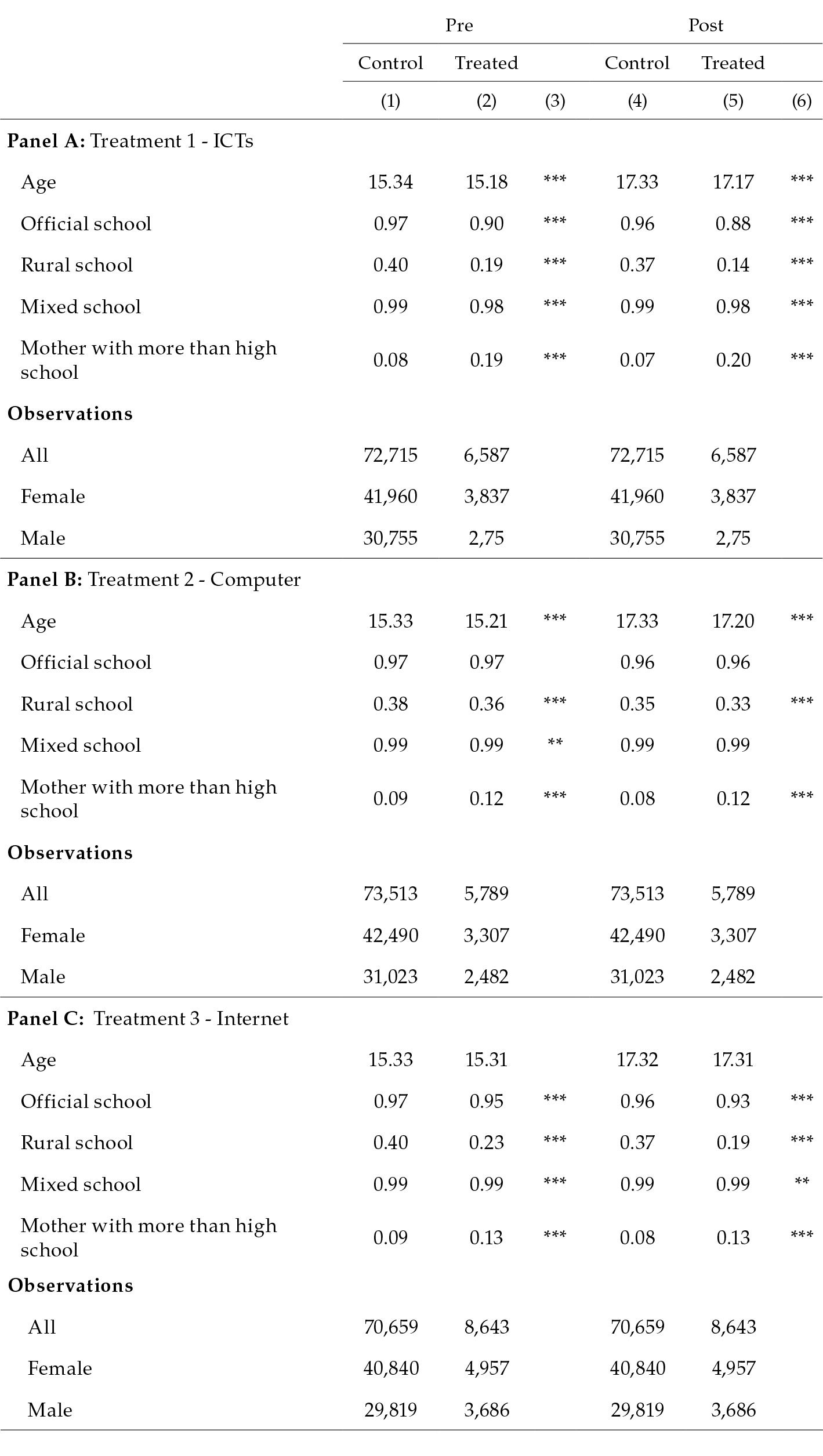
Source: Author's calculations, based on ICFES information. Column (3) and (6) indicate whether there is a significant difference between the controls and the treated groups according to the significance levels: *** p<0.01, ** p<0.05, * p<0.1
Formally, using the subscript i to denote individuals, s to denote schools, and t to denote year, we estimate the following difference-in-differences model of two periods:

where Ygist any of the educational achievement outcome variables (math score or reading score) and g indicates whether the estimated equation is for all, males or female<. Dt indicates whether a student has access to ICT in grade 11, and Postt is a dummy variable that takes the value of one for the year 2019 and as are school fixed effects that control for any? observed or unobserved time-invariant heterogeneity at the school level. Xi. are the student characteristics at the baseline period (2017) when they took the Saber 9 test. The vector p. includes the age of the students, mother schooling, the location of the school (rural or urban), the number of people living in the household, and whether the student was part of the controlled sample in Saber 9. Finally, eist is the error term, which we group at the individual level.
The main identifying assumption in this difference-in-differences (did) model is that, in the absence of the treatment (access to ICT), the educational achievement results of those who had access to ICT at the time of taking the Saber 11 test would have evolved similarly to the results of those students without access to ICT. Given that we have a two-period panel we cannot empirically test this assumption, however, it is plausible to think that students in grade 9 who did not have access to technologies in that year did not have it before since the percentage of students without access to technologies is higher in lower grades.6
Since the objective of the paper includes identifying whether the effect of ICT is similar for both sexes, the following model with interactions is proposed. Under this specification, the dummy variable Female is equal to one if the student is a woman and 0 if the student is a man. In this equation, the sum of the coefficients (β3 + β6) indicates the effect for women and (β3) indicates the effect for men.

4. Results
Table 4 shows the estimated coefficients from equation (1) for the three treatment measures evaluated. Even-numbered columns include baseline controls, while odd-numbered columns do not. All specifications account for school fixed effects. Panel A shows the coefficients for the treatment of Computer and Internet access, Panel B for Computer access, and Panel C for Internet access. Standard errors are clustered at the individual level and are reported in parentheses.
Table 4. Effects of ICT access on learning outcomes

Notes: The even columns show estimates with controls for the students age, mother's education, school location, household size, and whether the student was part of the controlled sample in Saber 9, as well as school fixed effects. The sample corresponds to students who have complete information for all socioeconomic variables. The outcome variables correspond to the standardized scores across different subject areas. The results are standardized. In panel A, the treatment indicates whether the student had access to a computer and Internet in Saber 11; in panel B, whether the student had access to a computer in Saber 11; and in panel C, whether the student had access to the Internet in Saber 11. Standard errors, clustered at the individual level, are reported in parentheses. *p < 0.1, ** p < 0.05, *** p < 0.01.
The results in Panel A indicate a positive effect of ICT access on math scores, with an average increase of 0.068 standard deviations that represents 29 °% relative to the control group's mean. No statistically significant effects are observed for reading scores. In Panel B, having a computer without Internet access shows no significant impact on math or reading scores. This result may be explained by the fact that the primary benefit of these tools comes from Internet connectivity and the ability to access a global network of knowledge. In Panel C, Internet access generates a statistically significant increase of 0.038 standard deviations in math scores and 0.024 in reading scores, representing gains of 17 % and 8 %, respectively, compared to the control group's mean.
Table 5 shows the estimated coefficients from equation (2), evaluating potential heterogeneous effects by gender for the three treatment measures. In Panel A, no statistically significant differences in the impact of ICT access on math scores between males and females are found, although the effect is slightly larger for females (0.019 standard deviations). However, this difference is not statistically significant. In Panel B, computer access without Internet shows a negative differential effect for females, with their math scores decreasing by a larger margin compared to males. In Panel C, Internet access alone does not show statistically significant differences in math scores between males and females, though the effect is smaller for females. Additionally, Internet access has a positive effect on reading scores for males but not for females.
Table 5. Heterogeneous effects of ICT access on learning outcomes
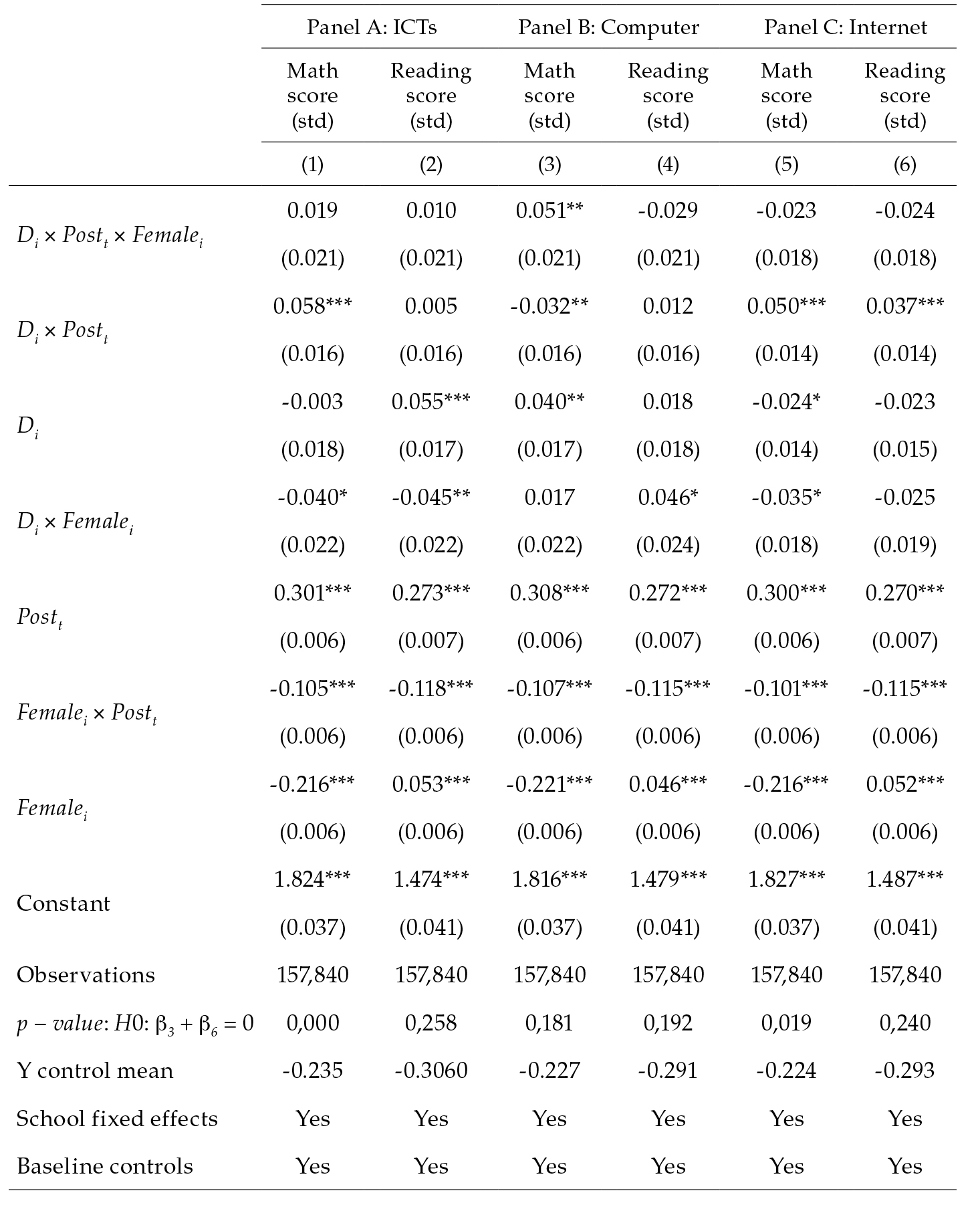
Notes: The even columns show estimates with controls for the students age, mother's education, school location, household size, and whether the student was part of the controlled sample in Saber 9, as well as school fixed effects. The sample corresponds to students who have complete information for all socioeconomic variables. The outcome variables correspond to the standardized scores across different subject areas. The results are standardized. In panel A, the treatment indicates whether the student had access to a computer and Internet in Saber 11; in panel B, whether the student had access to a computer in Saber 11; and in panel C, whether the student had access to the Internet in Saber 11. Standard errors, clustered at the individual level, are reported in parentheses. * p < 0.1, ** p < 0.05, *** p < 0.01
One possible explanation for the gender differences observed could be that girls are more likely to remain in the educational system until reaching grade 11 and take the Saber 11 exam. This could influence the magnitude of ICT access effects across genders, though the differences found are not statistically significant.
In the following section, the consistency of the observed effects will be examined using alternative specifications to assess the robustness of these results and their attribution to ICT use in math and reading academic performance.
5. Robustness
We present some evidence designed to rule out that the results in Table 4 and 5 may be seriously influenced by the existence of outliers in the Saber test results, either by changes in the sample, or by the gender imbalance in the number of males and females taking the Saber 11 test.
First, the estimation aims to identify whether there are departments that could yield significantly different results. To test this, each estimation is performed excluding the population of one department, with replacement. Figure 1 shows that the results for the three treatments, both for mathematics and reading, are robust and not driven by any specific department. The coefficients generally remain stable after excluding a department and re-estimating the model for the remaining 32 departments. This indicates that the estimations do not depend on the particular characteristics of any one department.
These results could also be explained by changes associated with gender-imbalanced dropout rates between grade 9 and grade 11. To discard that results do not depend on these changes in the sample of those who took the Saber 9 test but did not reach Saber 11, we estimate an econometric model that predicts math and reading scores using a vector of individual, household and school characteristics reported in the Saber 9 test. The predicted values provides an approximation of the expected Saber 11 score that would have been achieved by those students who did not take the test (Figure 2).
As shown in Figure 2, if the students who did not take the test had been able to do so, their average scores would likely have been lower, as the score distribution would have shifted to the left compared to the observed scores. To test the stability of the coefficients, an additional estimation was performed by removing the 5 percent of students with the lowest scores from the sample (Table 4 and 6, Panel 1). The results show that the coefficients remain stable, indicating that the effects do not change significantly with adjustments to the sample, even at the lower end of the distribution.
Figure 2. Distribution of scores in Saber 11 with and without the predictions of those absent in Saber 11 who were in Saber 9

Table 6.Robustness of the Effects of ICT Access on Learning Outcomes
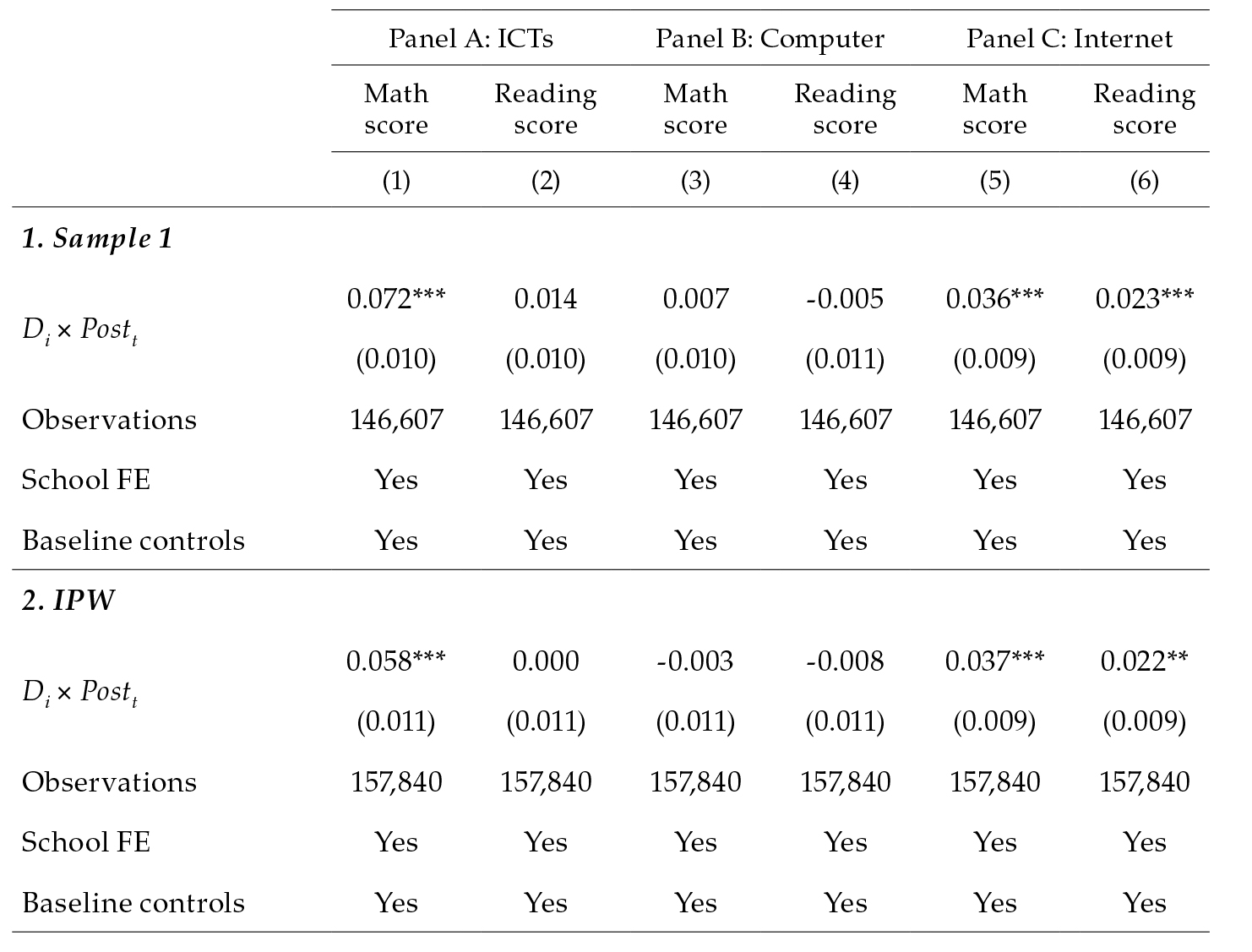
Notes: The even columns show estimates with controls for the students age, mother's education, school location, household size, and whether the student was part of the controlled sample in Saber 9, as well as school fixed effects. The sample corresponds to students who have complete information for all socioeconomic variables. The outcome variables correspond to the standardized scores across different subject areas. The results are standardized. In panel A, the treatment indicates whether the student had access to a computer and Internet in Saber 11; in panel B, whether the student had access to a computer in Saber 11; and in panel C, whether the student had access to the Internet in Saber 11. Standard errors, clustered at the individual level, are reported in parentheses. * p < 0.1, ** p < 0.05, *** p < 0.01
Additionally, we conducted an exercise where 500 random gender-balanced samples were drawn, and the main equation was estimated for each sample. Figure 3 summarizes the distribution of the treatment effects for these gender-balanced samples. We find that the estimated effects in our central model are not statistically different from those obtained with gender-balanced samples, indicating that the gender imbalance does not significantly impact the findings in our main specification.
Table 7. Robustness of the Heterogeneous Effects of ICT Access on Learning Outcomes
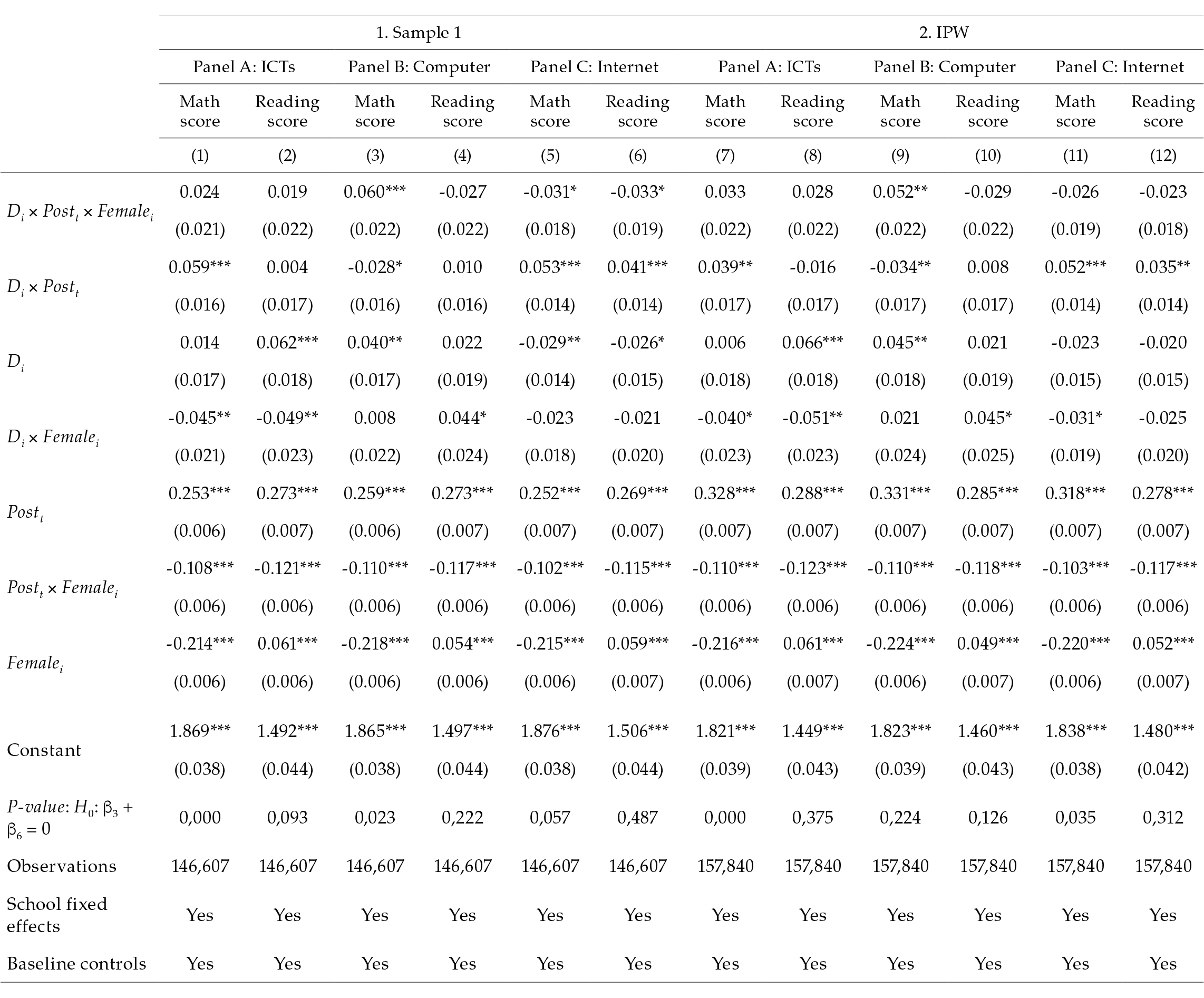
Notes: The even columns show estimates with controls for the students age, mother's education, school location, household size, and whether the student was part of the controlled sample in Saber 9, as well as school fixed effects. The sample corresponds to students who have complete information for all socioeconomic variables. The outcome variables correspond to the standardized scores across different subject areas. The results are standardized. In panel A, the treatment indicates whether the student had access to a computer and Internet in Saber 11; in panel B, whether the student had access to a computer in Saber 11; and in panel C, whether the student had access to the Internet in Saber 11. Standard errors, clustered at the individual level, are reported in parentheses. * p < 0.1, ** p < 0.05, *** p < 0.01
Figure 3. Distribution of treatment effect for gender-balanced random samples

Note: Calculation of the authors using Saber database (ICFES). The sample is balanced and takes 40,000 observations for each gender. 500 iterations of the model are performed to obtain the distribution of the effect.
Finally, to reduce the risk that the estimated results are not driven by the probability of being "treated", we applied the Inverse Probability Weighting (IPW) methodology, which accounts for the probability of treatment based on a set of individual, household, and school controls. Table 4 and 6, Panel 2, shows that the results obtained using the IPW method are consistent with those from the main specification, as they do not change significantly. This indicates that the results are not sensitive to the factors potentially influencing the probability of being treated.
6. Discussion
Access to ICTS during middle education is crucial for developing the academic skills required by the modern world. An unbiased measurement of its effects on individuals requires not only considering the availability of devices, but also having an approximation of their levels of use. This document uses some of the devices currently used to connect to the World Wide Web, but since we do not have information on others such as tablets or smartphones, it is possible to have a lower estimate of the effect.
The obtained results suggest that access to ICT indeed benefits middle school students in Colombia, after controlling for other socioeconomic factors. However, these results are uneven across fields of study and the different measures of ICT access. Owning a computer alone is not particularly relevant, given the growing presence of smartphones and tablets that allow personalized use of these devices.
Considering that a student without ICT access in grade 9 is likely to be under limited socioeconomic conditions, it is understandable that having access to both the Internet and a computer at home provides substantial benefits for them. However, a revealing result of this study is that owning a computer without the ability to use it to leverage the vast amount of knowledge available online does not contribute to academic performance, as measured by the Saber 11 test. Furthermore, for those with only Internet access, it has a greater effect on math scores for males in terms of standard deviations.
Our results allow us to debunk the myth of the asymmetric benefits from ICT for men and women. The effect of ICT access on mathematics scores is not statistically different between men and women so there is no evidence of gender digital divide in middle education in Colombia.
An important recommendation of this document is the call to improve the complementary information collected by the ICFES among the assessed population. Given the importance of ICT for education in the era of artificial intelligence, it is essential to deepen the understanding of access and usage intensity of all ICT devices. The rapidly growing demand for these devices has expanded ICT access among the population due to their functionality and practical requirements.
However, considering that the main objective of this study is to identify whether access to ICT contributes to narrowing academic score gaps, there is no evidence to suggest a gender-biased distribution of these modern devices. One implication of the findings is the need to identify mechanisms to improve reading skills and the potential benefits that Internet access can offer in this area.
Notas
1 Although the design of the tests does not intend to evaluate the same competencies in the two courses, they do allow evaluating progress in them. ICFES (2013).
2 This exam is administered twice a year due to two academic calendars. The first administration takes place around March for students following the B-calendar (August to June), and the second is for A-calendar schools, representing approximately 95% of the students who take the Saber 11 test.
3 The verbal analysis test assessed at Saber 9 is different from the critical reading test in Saber 11 since not exactly the same competencies are evaluated. Communicative-reading and communicative-writing competencies are evaluated in Saber 9, while Saber 11 includes three competencies, two of them deal with evaluating the comprehension of the content of a text and the other competency evaluates the critical approach to the text.
4 Municipalities with higher differences in reading in favor of women at Saber 9: Morichal, Almeida, Vetas, San Benito and Berbeo. In Saber 11 they were San Felipe, Almeida, Puerto Santander, Labranzagrande and Coper. In the case of math: the higher differences are in Morichal, Busbanzá, Sativanorte, Almeida and Medio Atrato; while in Saber 11 they were San Felipe, Almeida, Bituima, Susacón and Labranzagrande.
5 Table A1 in the Appendix shows the characteristics of the sample entering the empirical exercise compared to the matched sample.
6 For the year 2017, the proportion of students who took the Saber 5 test had lower access to technologies compared to the proportion of Saber 9 students for that year. This proportion was calculated from the Saber 5 database available in Data Icfes.
References
Angrist, J., & Lavy, V. (2002). New evidence on classroom computers and pupil learning. The Economic Journal, 112 (482), 735-765.
Barrera-Osorio, F., & Linden, L. L. (2009). The use and misuse of computers in education: evidence from a randomized experiment in Colombia. World Bank Policy Research Working Paper (4836).
Basavaraja, M., & Sampath Kumar, B. (2017). Gender disparities in the use of ict: A survey of students in urban schools. Journal of Information Science Theory and Practice, 5 (4), 39-48.
Bulman, G., & Fairlie, R. W. (2016). Technology and education: Computers, software, and the Internet. In Handbook of the economics of education (Vol. 5, pp. 239-280). Elsevier.
Campos, D. G., & Scherer, R. (2024). Digital gender gaps in students' knowledge, attitudes and skills: an integrative data analysis across 32 countries. Education and Information Technologies, 29 (1), 655-693.
Checchi, D., Rettore, E., & Girardi, S. (2019). IC technology and learning: an impact evaluation of Cl@ssi 2.0. Education Economics, 27 (3), 241-264.
Cristia, J., Ibarrarán, P., Cueto, S., Santiago, A., & Severín, E. (2017). Technology and child development: Evidence from the one laptop per child program. American Economic Journal: Applied Economics, 9 (3), 295-320.
Feng, S., Wong, Y. K., Wong, L. Y., & Hossain, L. (2019). The Internet and Facebook usage on academic distraction of college students. Computers & Education, 134, 41-49.
Gil-Flores, J., Torres-Gordillo, J. J., & Perera-Rodríguez, V. H. (2012). The role of online reader experience in explaining students' performance in digital reading. Computers & Education, 59 (2), 653-660.
Goolsbee, A., & Guryan, J. (2006). The impact of Internet subsidies in public schools. The Review of Economics and Statistics, 88 (2), 336-347.
Hanafizadeh, M. R., Saghaei, A., & Hanafizadeh, P. (2009). An index for cross-country analysis of ICT infrastructure and access. Telecommunications Policy, 33 (7), 385-405.
Hu, J., & Yu, R. (2021). The effects of ict-based social media on adolescents' digital reading performance: A longitudinal study of pisa 2009, pisa 2012, pisa 2015 and pisa 2018. Computers & Education, 175, 104342.
Hunley, S. A., Krise, J., Rich, T., & Schell, C. (2005). Adolescent computer use. Adolescence, 40 (158).
ICFES, S. (2013). Sistema nacional de evaluación estandarizada de la educación alineación del examen saber 11. Bogotá D.C.: ICFES.
Junco, R. (2012). The relationship between frequency of Facebook use, participation in Facebook activities, and student engagement. Computers & education, 58 (1), 162- 171.
Kirschner, P. A., & Karpinski, A. C. (2010). Facebook® and academic performance. Computers in human behavior, 26 (6), 1237-1245.
Lambić, D. (2016). Correlation between Facebook use for educational purposes and academic performance of students. Computers in Human Behavior, 61, 313-320.
Lei, J, & Zhao, Y. (2007). Technology uses and student achievement: A longitudinal study. Com puters & Education, 49 (2), 284-296.
Leuven, E., Lindahl, M., Oosterbeek, H., & Webbink, D. (2007). The effect of extra funding for disadvantaged pupils on achievement. The Review of Economics and Statistics, 89 (4), 721-736.
Martínez-Domínguez, M., & Mora-Rivera, J. (2020). Internet adoption and usage patterns in rural Mexico. Technology in society, 60, 101226.
Muls, J., Thomas, V., De Backer, F., Zhu, C., & Lombaerts, K. (2020). Identifying the nature of social media policies in high schools. Education and Information Technologies, 25 (1), 281-305.
Muñoz, J. S. (2018). The economics behind the math gender gap: Colombian evidence on the role of sample selection. Journal of Development Economics, 135, 368-391.
Ome, A., & Gamboa, L. (2021). Permanencia y valor agregado en la enseñanza media en Colombia. Vniversitas Económica, 21(1). Universidad Javeriana.
Posso, A. (2016). Internet usage and educational outcomes among 15-year old Australian students. International Journal of Communication, 10, 26.
Román Carrasco, M., & Murillo Torrecilla, F. J. (2012). Learning environments with techno- logical resources: a look at their contribution to student performance in Latin American elementary schools. Educational Technology Research and Development, 60 (6), 1107-1128.
Skryabin, M., Zhang, J., Liu, L., & Zhang, D. (2015). How the ICT development level and usage influence student achievement in reading, mathematics, and science. Computers & Education, 85, 49-58.
Su, W., Han, X., Yu, H., Wu, Y., & Potenza, M. N. (2020). Do men become addicted to Internet gaming and women to social media? a metaanalysis examining gender-related differences in specific Internet addiction. Computers in Human Behavior, 113, 106480.
Weiser, E. B. (2000). Gender differences in Internet use patterns and Internet application preferences: A two-sample comparison. Cyberpsychology and behavior, 3 (2), 167-178.
Wu, J. Y., & Peng, Y. C. (2017). The modality effect on reading literacy: Perspectives from students' online reading habits, cognitive and metacognitive strategies, and web navigation skills across regions. Interactive Learning Environments, 25 (7), 859-876.
Appendix
Table A1. Difference of means of control variables by gender
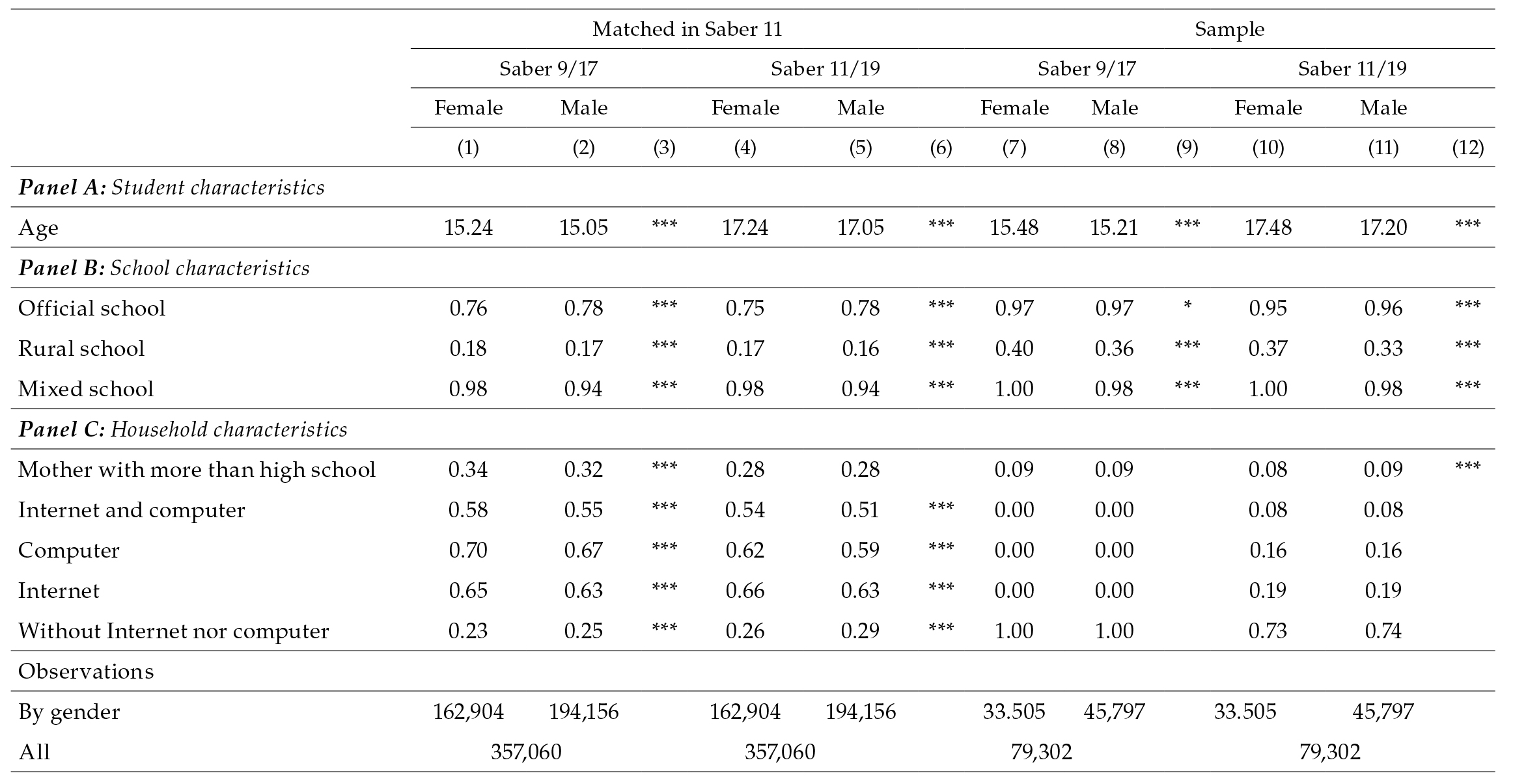
Notes: Author's calculations, based on ICFES information. *** p<0.01, ** p<0.05,* p<0.1
